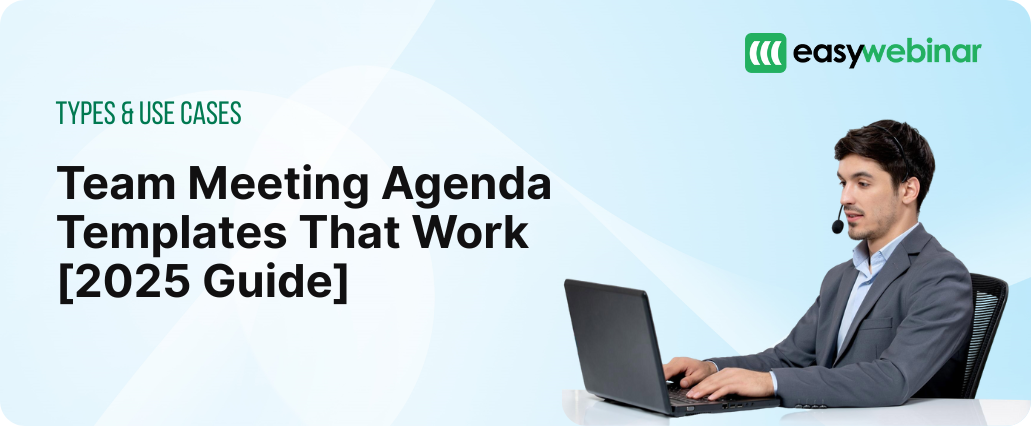Team Meeting Agenda Templates That Actually Work [Expert-Tested for 2025]

Summary :
Most meetings are unproductive due to a lack of structure and clear goals. This blog highlights expert-tested team meeting agenda templates that improve focus, accountability, and results. It explains the key components of a strong agenda, clear purpose, assigned roles, time-boxed items, and preparation materials, and offers a step-by-step guide to building your own.
It also shares 8 effective templates for different meeting types in 2025, including weekly team check-ins, executive sessions, remote meetings, sprint planning, and brainstorming. The blog emphasizes the importance of customizing templates based on team structure, company goals, and remote collaboration needs. Regular updates and feedback-driven changes help maintain effectiveness.
Structured agendas turn meetings into productive sessions that respect everyone’s time and drive real progress.
Table of Contents
- The anatomy of a great team meeting agenda
- Step-by-step guide to building your own agenda
- 8 Proven Team Meeting Agenda Formats to Inspire Your 2025 Meetings
- How to customize templates for your team’s needs
- Conclusion
- FAQs
The numbers tell a shocking story – just 30% of meetings prove productive, while only 37% actually follow an agenda. Your unproductive team gatherings can become focused, results-driven sessions that people eagerly attend with the right meeting agenda templates.
Teams waste precious hours each week in meetings that lack proper planning. Meetings without a well-laid-out agenda leave participants frustrated and questioning their presence. A carefully designed team meeting agenda template creates the foundation needed to succeed. The right template serves as your roadmap that guides discussions and covers all crucial points, whether you need a weekly format or something more specific.
This piece showcases expert-tested team meeting templates that will serve your organization through 2025 and beyond. We’ll help you turn those time-draining meetings into productivity powerhouses, with everything from Word-based templates to specialized formats that fit different scenarios.
The anatomy of a great team meeting agenda
A well-laid-out team meeting agenda serves as a roadmap that shows what needs to happen before and during a meeting. Your team meeting agenda template should include vital elements that optimize productivity and involvement.
Clear purpose and expected outcomes
The foundations of any successful team meeting agenda start with a clear definition of its purpose. You must establish what you want to accomplish before creating your agenda for team meeting template. To cite an instance, the meeting might focus on brainstorming, problem-solving, decision-making, or updating participants.
A powerful agenda shows the meeting’s overall goal and what you want to achieve from each discussion point. Your purpose statement should read: “In this meeting, we will [explore/debate/decide/finalize] TOPIC in order to TAKE CONCRETE ACTION”. This clarity guides discussion and keeps the meeting focused on achieving real results.
Defined roles and responsibilities
The team meeting template becomes more effective when you assign specific roles to participants before the meeting. This creates accountability and maintains structure. The core team should include:
- Leader/Chair – arranges, leads, and concludes the meeting
- Facilitator – keeps discussion and decision-making on track
- Timekeeper – ensures time efficiency
- Notetaker – documents key decisions and action items
Participants can prepare better when they know their roles, which results in more productive contributions.
Time-boxed agenda items
The quickest way to manage time requires specific time limits for each discussion point. To cite an instance, updates might need 10 minutes while strategic discussions could take 30 minutes. This approach creates a clear path and covers all significant points.
Specific time allocations prevent the meeting from losing focus or letting certain topics dominate the session. Time boxing also creates urgency that keeps everyone focused and involved.
Pre-meeting preparation materials
The weekly team meeting agenda template works better when you share the agenda and supporting documents early. Include links to relevant pre-reading materials like presentation decks, contextual information, or previous decisions.
Discussions move forward smoothly when everyone arrives prepared instead of getting stuck on simple questions. Participant involvement increases because people have time to think about topics and create thoughtful contributions.
Step-by-step guide to building your own agenda
A productive meeting needs more than just good intentions—it needs careful planning. Research shows that a meeting’s success depends not just on having an agenda, but on what’s actually included in it. Let me show you how to build your own team meeting agenda template that gets results:
Step 1: Identify the meeting type
Start by figuring out why you’re getting together. Think about what you want to achieve—updates, new ideas, or decisions. Each type of meeting (decision-making, problem-solving, brainstorming) needs a different approach. Your meeting’s main goal will help you pick the right topics and attendees.
Step 2: Gather input from participants
Team members who help create the agenda will be more likely to participate and you’ll cover what matters most. You can collect ideas through email, shared documents, or collaboration tools. Research shows this makes meetings more inclusive because everyone gets an equal chance to contribute. Make sure to set a deadline so you’re not rushing at the last minute.
Step 3: Structure the agenda logically
Put your most important topics at the top. Keep related items together so discussions stay focused. Schedule time-sensitive topics that need specific people early in the meeting. This way, people can leave early if they need to without missing their part.
Step 4: Assign owners and time slots
Give each item a specific time slot—experts suggest adding 20% more time than you think you’ll need. Pick someone to lead each topic who can guide the discussion and make sure everyone speaks up. When people know who’s responsible, discussions stay productive and everyone stays on track.
Step 5: Finalize and distribute
Polish your agenda and send it out at least 24 hours before the meeting. This gives everyone time to get ready, gather what they need, and think about what they’ll contribute. Include any materials people should read beforehand to make the meeting as productive as possible from the start.

8 Proven Team Meeting Agenda Formats to Inspire Your 2025 Meetings
Eight expert-tested team meeting agenda templates will help you maximize productivity and get people involved in various meeting scenarios through 2025. The right framework makes meetings work better.
1. Weekly team meeting agenda template
Weekly meeting templates are the life-blood of team coordination. They have sections for wins/accomplishments, roadblocks, upcoming priorities, and team shoutouts. Teams stay arranged and celebrate progress with this structure. A good template needs about 10 minutes to review metrics, 20 minutes to plan sprints, and 10 minutes to identify blockers.
2. Team meeting agenda template
Microsoft Word templates give teams accessibility and familiarity. The customizable formats include presenter information, time allocations, and spaces for action items. Many templates come with printable options and spaces to add virtual meeting details like call-in numbers and online meeting links.
3. Remote team meeting template
Remote teams face unique challenges when working across time zones. The best remote templates add video conferencing links, asynchronous update sections, and interactive elements like embedded whiteboards. Teams stay connected through sections that encourage virtual collaboration, provide status updates, and give quick access to important resources.
4. Sprint planning meeting agenda
Agile teams use these templates to select work for upcoming sprints. The well-laid-out sprint planning template includes previous sprint review, sprint goal definition, team velocity presentation, and capacity planning. Teams need time to refine backlogs and estimate story points.
5. Executive team meeting agenda
Strategic discussions and high-level decisions shape executive templates. Questions frame agenda items to clarify discussion purpose. The core team owns each topic and communicates follow-ups. Time limits keep discussions on track.
6. Project check-in meeting agenda
Project check-ins keep initiatives moving forward. Teams maintain momentum by reviewing objectives, milestones, and updates. The template helps identify roadblocks quickly and assigns clear ownership for next steps.
7. Brainstorming session agenda
Good brainstorming runs on structure. The template sets goals, ground rules, and activities that spark ideas. Teams share thoughts, vote on options, and plan actions. Innovation flourishes without losing direction.
8. Status update meeting agenda
Status templates help teams report progress and remove obstacles. Teams review metrics, share wins, discuss challenges, and set priorities. Everyone stays accountable while seeing how projects move forward.

How to customize templates for your team’s needs
The best team meeting agenda templates need customization to work well in your workplace. These changes go beyond looks. They help create tools that match your team’s working style.
Adjusting for team size and structure
Small teams work better with shared team meeting templates that have longer discussion sections. Larger teams just need strict timing and clear roles. Teams with flat structures should try templates where discussion leaders rotate to boost participation. Hierarchical teams might want formal approval sections and specific reporting chains.
Pro tip: Match your template’s details to your team’s experience level. New teams work better with more structure. Experienced teams can use simpler formats.
Incorporating company-specific goals
Your weekly team meeting agenda template should match your organization’s priorities. Add sections that link to performance indicators and strategic goals. Teams focused on customer happiness should review customer feedback regularly. Companies that value breakthroughs should add brainstorming sessions to their meetings.
Template headers should use your company’s language and match internal systems. This makes them relevant to your team’s everyday tasks.
Using templates for hybrid or remote teams
Remote and hybrid teams face unique challenges. Your team meeting agenda template Word documents should include:
- Virtual meeting rules and login details
- Time zones for global teams
- Ways to contribute before live meetings
- Extra time for tech issues
Templates should balance structure with flexibility to handle unexpected remote work situations.
When to switch formats or try new templates
Look for these signs that your template needs an update:
Less participation, meetings that run late, or talks that go off-topic show template fatigue. Team members often tell you when meetings aren’t efficient anymore.
Try new formats every three months or after big team changes. This keeps everyone engaged and meetings fresh.
Conclusion
Good meetings don’t just happen—they need careful planning and structure. This piece shows how the right team meeting agenda templates can turn chaotic gatherings into productive sessions that get real work done.
Team meeting agenda templates act as your guide to meeting success. The stats are clear: all but one of these meetings fail to reach their goals. People often leave agenda-less meetings questioning why they showed up at all.
You now know what makes a great agenda—clear goals, defined roles, time-boxed items, and proper prep materials. These elements help you build frameworks that value everyone’s time and deliver results. Our step-by-step process gives you a reliable way to create purposeful agendas instead of basic topic lists.
The eight specialized templates for 2025 are a great way to get solutions for different meeting types. You’ll find formats for weekly team meetings, executive sessions, and brainstorming sessions. Each template gives you a solid base to build on.
Note that customization is key to long-term success. Your team’s size, setup, company goals, and work style should shape how you use these templates.
The best templates grow with your team. Watch for signs that your templates need refreshing, especially when meetings become less productive. Templates create structure, but their real value lies in helping teams work together and reach goals.
Well-laid-out meetings with smart agendas respect everyone’s time and push projects forward. Your team will appreciate trading unfocused discussions for productive sessions that deliver real results.
FAQs
Q1. How can I create an effective team meeting agenda?
To create an effective team meeting agenda, start by clearly defining the meeting’s purpose and expected outcomes. Include time-boxed agenda items, assign roles and responsibilities, and distribute pre-meeting preparation materials. Structure your agenda logically, placing critical items at the top, and involve team members in the agenda creation process.
Q2. What are the key components of a great team meeting agenda?
A great team meeting agenda includes a clear purpose statement, defined roles for participants, time-boxed agenda items, and pre-meeting preparation materials. It should also have a logical structure, with topics arranged in order of importance and grouped by relevance.
Q3. How often should I update my team meeting agenda template?
It’s a good practice to review and potentially update your team meeting agenda template quarterly or after significant team changes. Watch for signs of template fatigue, such as decreasing participation, meetings running overtime, or frequent off-topic discussions. Experimenting with new formats can help maintain engagement and efficiency.
Q4. What’s the best way to customize a team meeting agenda for remote or hybrid teams?
When customizing for remote or hybrid teams, include virtual participation protocols, connection details, and time zone accommodations. Add sections for asynchronous contributions and technology troubleshooting. Balance structure with flexibility to accommodate the unique challenges of remote collaboration.
Q5. How can I ensure my team meeting stays on track and accomplishes its goals?
To keep your meeting on track, use a well-structured agenda with clear objectives and time allocations for each item. Assign a facilitator to guide discussions and a timekeeper to maintain efficiency. Distribute the agenda and any necessary materials in advance, allowing participants to prepare. Regularly review and adjust your meeting format based on team feedback and effectiveness.
